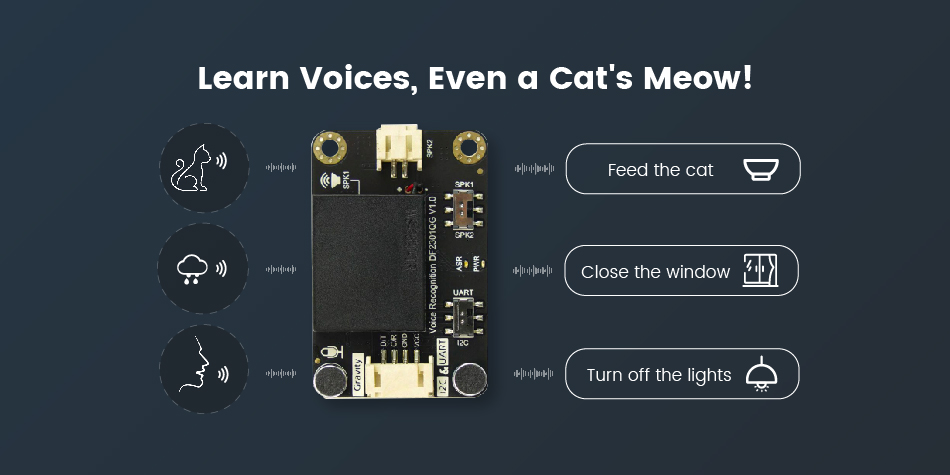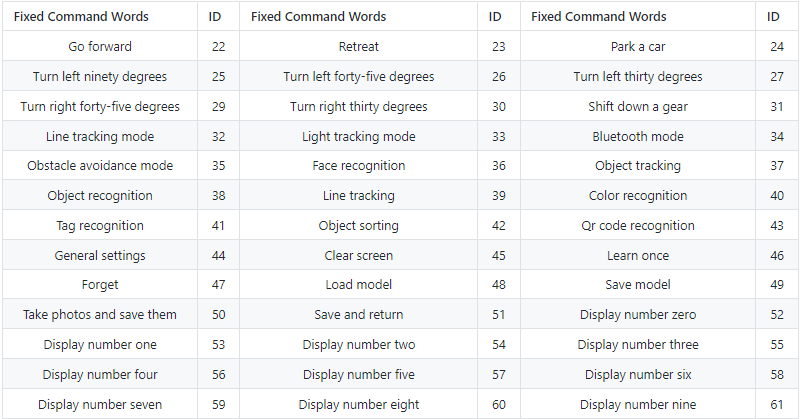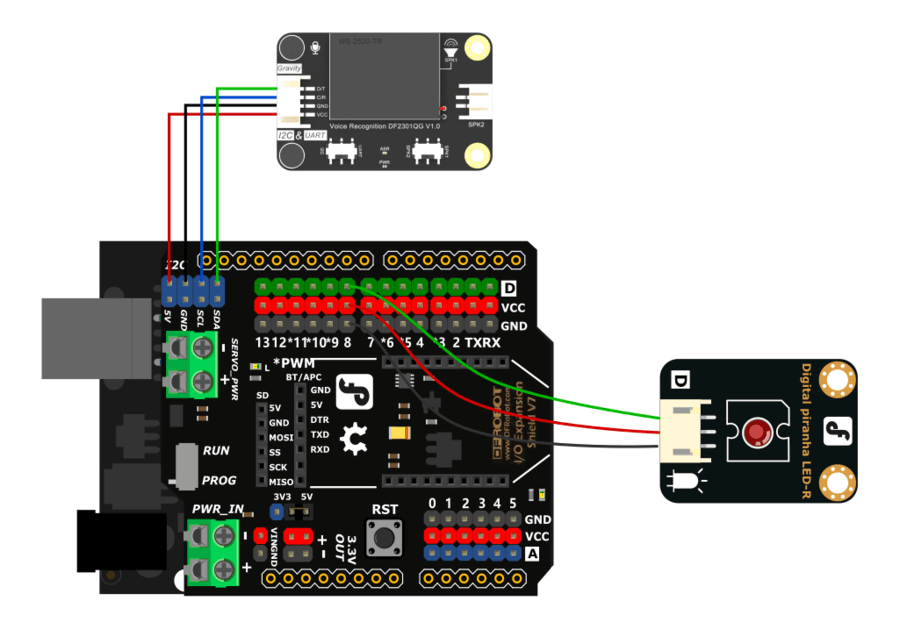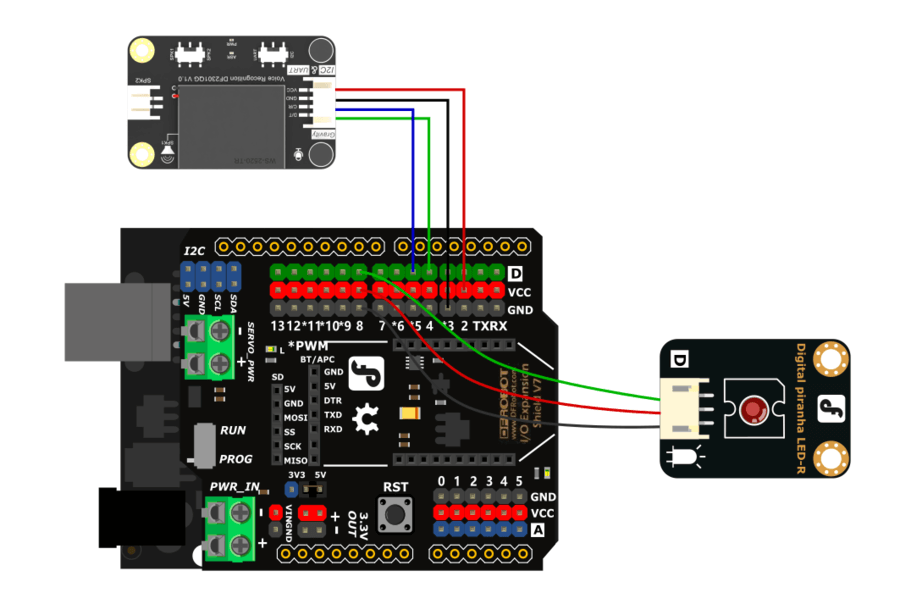{{CMP.TITLE}}
{{CMP.DESCRIPTION}}
- Ürün Özellikleri
- İade ve Teslimat
- Ödeme Seçenekleri
- Yorumlar (0)
- Beni Ara
- Ek
-
INTRODUCTION
What is voice recognition?
Voice recognition is a computer technology that recognizes and converts speech signals into editable text or operational commands through analysis. It allows people to interact with computers by speaking without using a mouse, keyboard, or other input devices. Voice recognition technology has been widely used in applications such as voice assistants, smart homes, voice search, and voice recognition notebooks.
What is Gravity: offline language learning voice recognition sensor?
Gravity: offline speech recognition sensor is built around an offline voice recognition chip, which can be directly used without an internet connection. It comes with 121 built-in fixed command words and supports the addition of 17 custom command words. Meanwhile, this voice recognition module compatibility with multiple common controllers enables it to provide a flexible solution for makers and electronics enthusiasts in terms of voice interaction. It can be applied to any application that requires voice control or interaction, such as various smart home appliances, toys, lighting fixtures, and robotics projects, among others.
Self-Learning Function
The voice recognition module is equipped with a self-learning function and supports the addition of 17 custom command words. Any sound could be trained as a command, such as whistling, snapping, or even cat meows, which brings great flexibility to interactive audio projects.
For instance automatic pet feeder. When a cat emits a meow, the offline voice recognition module can recognize the meow and trigger the feeder to automatically provide food for the cat. This innovative design ensures that the owner can promptly meet the cat's dietary needs. Moreover, the product is equipped with excellent noise resistance and long-distance recognition capabilities, allowing for precise identification of the cat's meows even in noisy environments.

Figure: Voice Recognition Sensor Self-Learning Function
User-Friendly
The offline speech recognition sensor boasts a user-friendly design. It comes with 121 built-in fixed command words, eliminating the need for users to record their own voices.
For instance, in an intelligent window system, when it starts to rain or thunder, there's no need for manual window operation. The offline voice recognition module can recognize the pre-set command word "close the window," triggering the automatic closing of the window to cope with sudden weather changes.

Figure: 121 built-in fixed command words
Real-Time Voice Feedback
The language learning voice recognition module features a dual microphone design with better noise resistance and a longer recognition distance, making it relatively accurate and reliable even in noisy environments. It comes with a built-in speaker and an external speaker interface for real-time voice feedback of recognition results.
For instance, one can wake up a voice assistant using a wake-up word, and the assistant promptly responds and begins learning or utilizing command words. When learning or deleting command words, the voice assistant also provides immediate feedback on the success of the operation. This greatly enhances the user's experience and convenience.

Figure: Real-Time Voice Feedback
High Compatibility
The module boasts high compatibility, supporting both I2C and UART communication methods, while also being compatible with various 3.3V or 5V controllers, such as micro:bit, Arduino (Arduino UNO, Arduino Leonardo, Arduino MEGA), Raspberry Pi, FireBeetle ESP32 series, and more. This provides a flexible solution for building smart home systems, robotics projects, and more.

Figure: Wiring Diagram of Voice Recognition Module, Arduino Uno, and LED Light Module - I2C

Figure: Wiring Diagram of Voice Recognition Module, Arduino Uno, and LED Light Module - UART
The pros and cons of offline and online voice recognition:
Pros
Cons
Offline Speech Recognition
1. Quickly respond to corresponding command words and instructions.
2. No need for a network.
3. If speech recognition fails, it will not affect the use of other product functions.
4. More secure privacy, users don't have to worry about their conversation content being recorded and uploaded to the cloud.
5. Small module size, convenient for embedding in applications.
6. Cheaper price.
Command words are fixed, and there may be limitations on the number and length of words.
Online Speech Recognition
1. Consumers are easy to use and not limited to command words.
2. Easy to develop, and there are many solutions in the market.
1. Requires network connection to connect to the cloud.
2. Response speed depends on the network speed.
3. Higher cost.
FEATURES
- Self-learning function: Control the module to learn command words by the voice, and any audio can be trained as a command
- Support I2C and UART, with a Gravity interface
- Compatible with 3.3V/5V
- Built-in with 121 commonly-used fixed command words
- The module has a built-in speaker and an interface for an external speaker, which can provide real-time voice feedback on recognition results
- Equipped with power indicator (red) and recognition status indicator (blue)
- Dual microphones provide better noise resistance and longer recognition distance
- Compatible with Arduino controllers: Arduino UNO, Arduino Leonardo, Arduino MEGA, FireBeetle series controllers, Raspberry Pi, ESP32
APPLICATIONS
- Voice recognition interaction
- Voice-controlled terminal
- Competition and project development
SPECIFICATION
- Operating Voltage: 3.3 - 5V
- Maximum Operating Current: ≤370 mA (5V)
- Communication: I2C/UART
- I2C Address: 0x64
- Fixed Command: 121
- Fixed Wake-up Command: 1
- Custom Command: 17
- Learning Activation Command: 1
- Onboard Microphone Sensitivity: -28db
- Module Size: 49×32 mm/1.93×1.26”
DOCUMENTS













